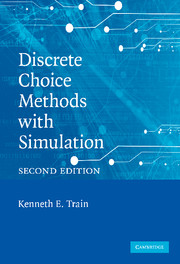3 - Logit
Published online by Cambridge University Press: 05 June 2012
Summary
Choice Probabilities
By far the easiest and most widely used discrete choice model is logit. Its popularity is due to the fact that the formula for the choice probabilities takes a closed form and is readily interpretable. Originally, the logit formula was derived by Luce (1959) from assumptions about the characteristics of choice probabilities, namely the independence from irrelevant alternatives (IIA) property discussed in Section 3.3.2. Marschak (1960) showed that these axioms implied that the model is consistent with utility maximization. The relation of the logit formula to the distribution of unobserved utility (as opposed to the characteristics of choice probabilities) was developed by Marley, as cited by Luce and Suppes (1965), who showed that the extreme value distribution leads to the logit formula. McFadden (1974) completed the analysis by showing the converse: that the logit formula for the choice probabilities necessarily implies that unobserved utility is distributed extreme value. In his Nobel lecture, McFadden (2001) provides a fascinating history of the development of this path-breaking model.
To derive the logit model, we use the general notation from Chapter 2 and add a specific distribution for unobserved utility. A decision maker, labeled n, faces J alternatives. The utility that the decision maker obtains from alternative j is decomposed into (1) a part labeled Vnj that is known by the researcher up to some parameters, and (2) an unknown part εnj that is treated by the researcher as random: Unj = Vnj + εnj ∀j.
- Type
- Chapter
- Information
- Discrete Choice Methods with Simulation , pp. 34 - 75Publisher: Cambridge University PressPrint publication year: 2009
- 1
- Cited by



